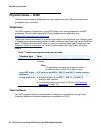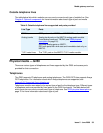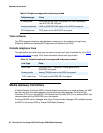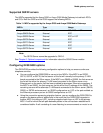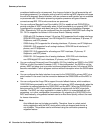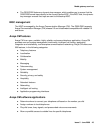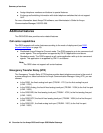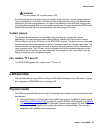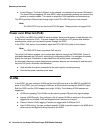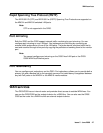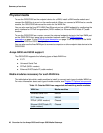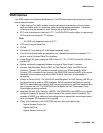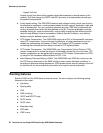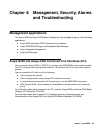
Summary of services
46 Overview for the Avaya G250 and Avaya G350 Media Gateways
● Fixed LAN port. The fixed LAN port on the chassis, connected to the internal LAN switch.
The fixed LAN port supports HP auto-MDIX, which automatically detects and corrects the
polarity of crossed cables. This results in simplified LAN installation and maintenance.
The G250 provides LAN services through eight fixed ETH LAN PoE ports on the chassis.
Note:
Note: The G250-DCP only has two fixed ETH LAN ports. These ports do not support PoE.
Power over Ethernet (PoE)
In the G350, the MM314 and MM316 media modules’ ports provide power to data devices over
the Ethernet connection (PoE). The ports support the connection of IP phones and wireless
access points, which you may want to power through the G350.
In the G250, PoE service is provided by eight fixed ETH LAN PoE ports on the chassis.
Note:
Note: The G250-DCP does not provide PoE service.
The inline PoE feature enables you to power data devices through the G250/G350. Power is
distributed between the PoE ports, according to configured priorities. You configure the power
priority on each port. Distribution is calculated from the actual power consumption.
An automatic discovery system detects when powered devices are connected to and removed
from the PoE ports. Automatic load detection:
● Tests whether the device connected to the port requires remote powering
● Controls the power injection to the wires
VLANs
In the G350, you can configure VLANs on the fixed LAN port and on the MM314 and MM316
ports. In the G250, you can configure VLANs on all Ethernet ports except the WAN ETH port.
Both the G250 and the G350 support up to eight VLANs. The following VLAN features are
supported:
● VLAN port grouping. Port VLANs can be used to group LAN ports into logical groups.
● Ingress VLAN Security. You configure a list of ingress VLANs on each port. Any packets
tagged with an unlisted VLAN are dropped when received on the port.
● Class of Service (CoS) tagging. Packets are tagged with VLANs per CoS.
● Inter-VLAN routing. You can configure specific VLANs to permit access to the WAN while
others can be configured to deny access to the WAN.



